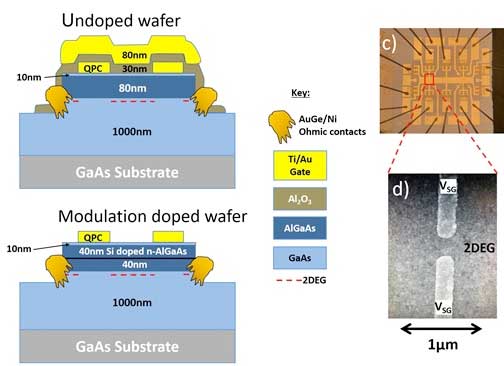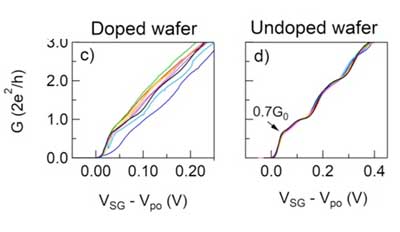| Nov 17, 2020 |
Making better quantum devices
(Nanowerk News) A UNSW-led collaboration has found that removing random doping in quantum electronic devices dramatically improves their reproducibility – a key requirement for future applications such as quantum-information processing and spintronics (Applied Physics Letters, "Improving reproducibility of quantum devices with completely undoped architectures").
|
 |
| Left: Wafer structures– undoped (top) and n-type doped (bottom). Right: Completed device on undoped wafer and electron microscope image. (Image courtesy of the researhers)
|
The quantum reproducibility challenge
|
|
The challenge with making quantum devices is that, until now, it has not been possible to make two quantum transistors that show identical performance characteristics.
|
|
Although the devices look identical physically, their electrical performance can vary dramatically from one device to the next. This makes integrating multiple quantum components into a complete quantum circuit challenging.
|
|
In the new, UNSW-led study, researchers show that the problem comes from the random spatial position of dopants in quantum devices.
|
|
The conventional approach to making semiconductors conduct electricity is to chemically dope it with another element. For example a very small amount of phosphorus atoms added to silicon produce an excess of free electrons, allowing an electrical current to flow
|
|
But in nanoscale quantum devices the random positioning of these dopants means that no two devices show identical characteristics.
|
|
The UNSW-led team worked with collaborators in Cambridge to show removing the dopants altogether makes quantum devices dramatically more reproducible.
|
 |
| On the left, nine identical devices on a doped wafer show different electronic behaviours, whereas on the right nine devices without doping are almost indistinguishable. (Image courtesy of the researhers)
|
|
Lead author Ashwin Srinivasan commented “The electrical gain of the undoped quantum point contact transistors is up to three times more uniform for the new approach, compared to conventional doped devices”.
|
|
Professor Hamilton, head of the Quantum Devices laboratory at UNSW, Sydney, said that “We had suspected that removing the random doping would improve the device reproducibility, but the results were vastly better than we anticipated. Ashwin made nine devices, and all showed identical quantum properties and electrical performance. I’d never seen anything like that before.”
|
|
“This work shows that it is possible to reproducibly manufacture quantum devices.”
|


